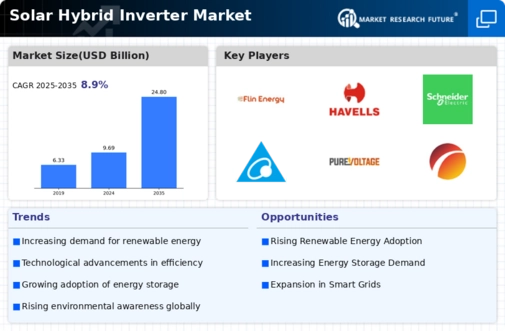Leading market players are investing heavily in research and development in order to expand their product lines, which will help the Solar Hybrid Inverter market, grow even more. Market participants are also undertaking a variety of strategic activities to expand their footprint, with important market developments including new product launches, contractual agreements, mergers and acquisitions, higher investments, and collaboration with other organizations. To expand and survive in a more competitive and rising market climate, Solar Hybrid Inverter industry must offer cost-effective items.
Manufacturing locally to minimize operational costs is one of the key business tactics used by manufacturers in the Solar Hybrid Inverter industry to benefit clients and increase the market sector. In recent years, the Solar Hybrid Inverter industry has offered some of the most significant advantages to medicine.
Major players in the Solar Hybrid Inverter market, including Flin Energy (India), Havells (India), Schneider Electric (France), Microtek Inverters (India), Delta Energy Systems (Germany), Pure Volt (India), Su-Kam power systems (India), Redback Technologies (Australia), Luminous (India), EAST Group (China), KACO new energy (Germany), Tabuchi Electric (US), SolarEdge Technologies (Israel), Voltronic Power Technology (Taiwan), and SolaX Power (China) and others, are attempting to increase market demand by investing in research and development operations.
Flin Energy company specializes in the development, manufacturing, and distribution of solar hybrid inverters, which are essential components in solar power systems. Solar hybrid inverters by Flin Energy are made to effectively transform solar power from photovoltaic (PV) panels into electrical energy used for buildings, companies, and other purposes. These inverters effortlessly combine solar power with the grid infrastructure already in place, allowing consumers to optimise energy use, lower electricity costs, and help the environment. The solar hybrid inverters from Flin Energy are renowned for their top-notch design, cutting-edge features, and dependable performance.
Utilising cutting-edge technology and stringent testing procedures, the company makes sure that its products adhere to international standards and deliver enduring performance across a variety of operating circumstances.
Flin Energy also places an emphasis on user-friendly designs and provides simple monitoring systems so that users can monitor and control their energy production and usage. Sustainability and the shift to renewable energy sources are important to Flin Energy. Its solar hybrid inverters are made with the goal of promoting energy independence while also maximising energy efficiency and minimising environmental effect.
The inverters from Flin Energy have energy storage features that enable users to store extra solar energy and use it during times of low sunshine or power outages, improving grid resilience and supplying a steady source of power. The company's commitment to providing great customer service and client-centric business practises has enhanced its standing in the marketplace. To ensure client satisfaction and the seamless integration of their solar hybrid inverters, Flin Energy offers thorough pre-sales support, technical help, and after-sales services.
Schneider Electric is a multinational company that operates in various sectors, including the solar hybrid inverter market. Schneider Electric is a prominent participant in the energy management and automation sector with a long history and a presence. Solar hybrid inverters are among the several solar power system solutions that Schneider Electric provides. Their solar hybrid inverters are made to efficiently convert solar energy into electrical power used for domestic, commercial, and industrial uses.
Advanced power electronics and control technologies are incorporated into these inverters to maximise energy production, enhance efficiency, and guarantee grid compatibility. The solar hybrid inverters produced by the company are renowned for their dependability, toughness, and high conversion efficiency. Schneider Electric uses its knowledge of energy management to deliver smart, scalable solutions that adapt to changing customer needs. Their inverters have cutting-edge monitoring and communication features that let consumers manage their solar power systems in real-time.























Leave a Comment